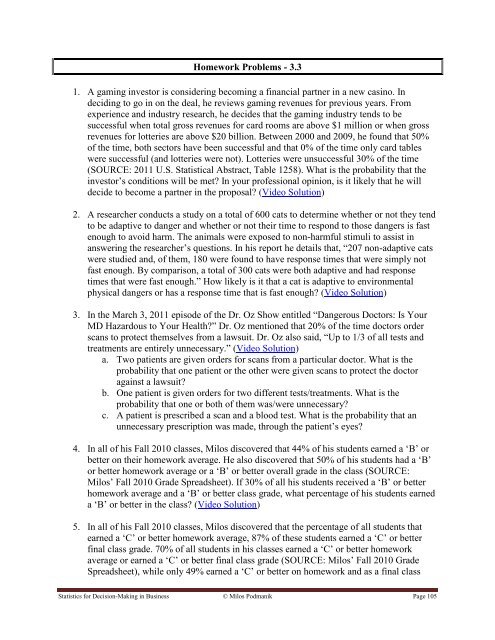Statistics for Decision- Making in Business - Maricopa Community ...
Statistics for Decision- Making in Business - Maricopa Community ...
Statistics for Decision- Making in Business - Maricopa Community ...
Create successful ePaper yourself
Turn your PDF publications into a flip-book with our unique Google optimized e-Paper software.
Homework Problems - 3.3<br />
1. A gam<strong>in</strong>g <strong>in</strong>vestor is consider<strong>in</strong>g becom<strong>in</strong>g a f<strong>in</strong>ancial partner <strong>in</strong> a new cas<strong>in</strong>o. In<br />
decid<strong>in</strong>g to go <strong>in</strong> on the deal, he reviews gam<strong>in</strong>g revenues <strong>for</strong> previous years. From<br />
experience and <strong>in</strong>dustry research, he decides that the gam<strong>in</strong>g <strong>in</strong>dustry tends to be<br />
successful when total gross revenues <strong>for</strong> card rooms are above $1 million or when gross<br />
revenues <strong>for</strong> lotteries are above $20 billion. Between 2000 and 2009, he found that 50%<br />
of the time, both sectors have been successful and that 0% of the time only card tables<br />
were successful (and lotteries were not). Lotteries were unsuccessful 30% of the time<br />
(SOURCE: 2011 U.S. Statistical Abstract, Table 1258). What is the probability that the<br />
<strong>in</strong>vestor‟s conditions will be met In your professional op<strong>in</strong>ion, is it likely that he will<br />
decide to become a partner <strong>in</strong> the proposal (Video Solution)<br />
2. A researcher conducts a study on a total of 600 cats to determ<strong>in</strong>e whether or not they tend<br />
to be adaptive to danger and whether or not their time to respond to those dangers is fast<br />
enough to avoid harm. The animals were exposed to non-harmful stimuli to assist <strong>in</strong><br />
answer<strong>in</strong>g the researcher‟s questions. In his report he details that, “207 non-adaptive cats<br />
were studied and, of them, 180 were found to have response times that were simply not<br />
fast enough. By comparison, a total of 300 cats were both adaptive and had response<br />
times that were fast enough.” How likely is it that a cat is adaptive to environmental<br />
physical dangers or has a response time that is fast enough (Video Solution)<br />
3. In the March 3, 2011 episode of the Dr. Oz Show entitled “Dangerous Doctors: Is Your<br />
MD Hazardous to Your Health” Dr. Oz mentioned that 20% of the time doctors order<br />
scans to protect themselves from a lawsuit. Dr. Oz also said, “Up to 1/3 of all tests and<br />
treatments are entirely unnecessary.” (Video Solution)<br />
a. Two patients are given orders <strong>for</strong> scans from a particular doctor. What is the<br />
probability that one patient or the other were given scans to protect the doctor<br />
aga<strong>in</strong>st a lawsuit<br />
b. One patient is given orders <strong>for</strong> two different tests/treatments. What is the<br />
probability that one or both of them was/were unnecessary<br />
c. A patient is prescribed a scan and a blood test. What is the probability that an<br />
unnecessary prescription was made, through the patient‟s eyes<br />
4. In all of his Fall 2010 classes, Milos discovered that 44% of his students earned a „B‟ or<br />
better on their homework average. He also discovered that 50% of his students had a „B‟<br />
or better homework average or a „B‟ or better overall grade <strong>in</strong> the class (SOURCE:<br />
Milos‟ Fall 2010 Grade Spreadsheet). If 30% of all his students received a „B‟ or better<br />
homework average and a „B‟ or better class grade, what percentage of his students earned<br />
a „B‟ or better <strong>in</strong> the class (Video Solution)<br />
5. In all of his Fall 2010 classes, Milos discovered that the percentage of all students that<br />
earned a „C‟ or better homework average, 87% of these students earned a „C‟ or better<br />
f<strong>in</strong>al class grade. 70% of all students <strong>in</strong> his classes earned a „C‟ or better homework<br />
average or earned a „C‟ or better f<strong>in</strong>al class grade (SOURCE: Milos‟ Fall 2010 Grade<br />
Spreadsheet), while only 49% earned a „C‟ or better on homework and as a f<strong>in</strong>al class<br />
<strong>Statistics</strong> <strong>for</strong> <strong>Decision</strong>-<strong>Mak<strong>in</strong>g</strong> <strong>in</strong> Bus<strong>in</strong>ess © Milos Podmanik Page 105
















